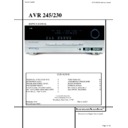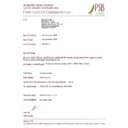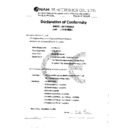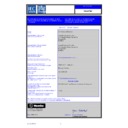Read Harman Kardon AVR 245 (serv.man4) Service Manual online
AVR 245/230
SERVICE MANUAL
harman/kardon
®
Power for the Digital Revolution®
harman/kardon
AVR 245/230 service manual
Page 1 of 82
CONTENTS
TECHNICAL SPECIFICATIONS
2
PCB DRAWINGS
61
OPERATION GUIDE
3
DISASSEMBLY PROCEDURE
70
TROUBLESHOOTING GUIDE
5
BLOCK DIAGRAM
71
PROCESSOR RESET
5
WIRING DIAGRAM
72
PACKING AND PACKING PARTS
6
AMP BIAS ADJUSTMENT
73
UNIT EXPLODED VIEW AND PARTS
7
SCHEMATIC DIAGRAMS
74
ELECTRICAL PARTS LIST
8
harman/kardon, Inc.
250 Crossways Park Dr.
Woodbury, New York, 11797
Released 2007
Rev 0, 9/2007
Discontinued XXXX
TECHNICAL SPECIFICATIONS 53
Technical Specifications
Audio Section
Stereo Mode
Continuous Average Power (FTC)
Stereo Mode
Continuous Average Power (FTC)
65 Watts per channel, 20Hz–20kHz,
@ < 0.07% THD, both channels driven into 8 ohms
@ < 0.07% THD, both channels driven into 8 ohms
7 Channel Surround Modes
Power Per Individual Channel
Power Per Individual Channel
Front L&R channels:
50 Watts per channel,
@ < 0.07% THD, 20Hz–20kHz into 8 ohms
50 Watts per channel,
@ < 0.07% THD, 20Hz–20kHz into 8 ohms
Center channel:
50 Watts, @ < 0.07% THD, 20Hz–20kHz into 8 ohms
50 Watts, @ < 0.07% THD, 20Hz–20kHz into 8 ohms
Surround (L & R Side, Back) channels:
50 Watts per channel,
@ < 0.07% THD, 20Hz–20kHz into 8 ohms
50 Watts per channel,
@ < 0.07% THD, 20Hz–20kHz into 8 ohms
Input Sensitivity/Impedance
Linear (High Level)
200mV/47kohms
Signal-to-Noise Ratio (IHF-A)
100dB
Surround System Adjacent Channel Separation
Analog Decoding
40dB
(Pro Logic, etc.)
Dolby Digital (AC-3)
Dolby Digital (AC-3)
55dB
DTS
55dB
Frequency Response
@ 1W (+0dB, –3dB)
10Hz–130kHz
High Instantaneous
Current Capability (HCC)
Current Capability (HCC)
±35 Amps
Transient Intermodulation
Distortion (TIM)
Distortion (TIM)
Unmeasurable
Rise Time
16 µsec
Slew Rate
40V/µsec**
FM Tuner Section
Frequency Range
87.5–108MHz
Usable Sensitivity
IHF 1.3 µV/13.2dBf
Signal-to-Noise Ratio
Mono/Stereo: 70/68dB (DIN)
Distortion
Mono/Stereo: 0.2/0.3%
Stereo Separation
40dB @ 1kHz
Selectivity
±400kHz: 70dB
Image Rejection
80dB
IF Rejection
90dB
AM Tuner Section
Frequency Range
522–1620kHz
Signal-to-Noise Ratio
45dB
Usable Sensitivity
Loop: 500µV
Distortion
1kHz, 50% Mod: 0.8%
Selectivity
±10kHz: 30dB
Video Section
Video Format
PAL/NTSC
Input Level/Impedance
1Vp-p/75 ohms
Output Level/Impedance
1Vp-p/75 ohms
Video Frequency Response
(Composite and S-Video)
(Composite and S-Video)
10Hz–8MHz (-3dB)
Video Frequency
Response (Component)
Response (Component)
10Hz–100MHz (-3dB)
General
Power Requirement
AC 220–240V/50Hz
Power Consumption
65W idle, 540W maximum
(7 channels driven)
(7 channels driven)
Dimensions (Max)
Width
440mm
Height
165mm
Depth
382mm
Weight
13.6 kg
Depth measurement includes knobs, buttons and terminal connections.
Height measurement includes feet and chassis.
All features and specifications are subject to change without notice.
Height measurement includes feet and chassis.
All features and specifications are subject to change without notice.
Harman Kardon, The Bridge
and Logic 7 are
registered trademarks of Harman International Industries, Incorporated.
is a trademark of Harman International Industries, Inc.
*Manufactured under license from Dolby Laboratories.
“Dolby,” “Pro Logic” and the Double-D symbol are trademarks of Dolby Laboratories.
“Dolby,” “Pro Logic” and the Double-D symbol are trademarks of Dolby Laboratories.
Please change to "DTS", "DTS ES", "Neo:6" and "96/24" are trademarks of DTS, Inc.
HDMI is a trademark of HDMI Licensing LLC.
SA-CD is a trademark of Sony Electronics, Inc.
Apple and iPod are registered trademarks of Apple Computer
, Inc.
Cirrus is a registered trademark of Cirrus Logic Corp.
**Without input anti slewing and output isolation networks.
30545_AVR245_ENG 19/10/06 12:21 Side 53
harman/kardon
AVR 245/230 service manual
Page 2 of 82
32
OPERATION
Operation
Surround Mode Chart
MODE
FEATURES
DOLBY DIGITAL
Available only with digital input sources encoded with Dolby Digital data. It provides up to
five separate main audio channels and a special dedicated Low Frequency Effects channel.
five separate main audio channels and a special dedicated Low Frequency Effects channel.
DOLBY DIGITAL EX
Available when the receiver is configured for 6.1/7.1 channel operation, Dolby Digital EX is the
latest version of Dolby Digital. When used with movies or other programs that have special
encoding, Dolby Digital EX reproduces specially encoded soundtracks so that a full 6.1/7.1
soundfield is available. When the receiver is set for 6.1/7.1 operation and a Dolby Digital signal is
present, the EX mode is automatically selected. Even if specific EX encoding is not available to
provide the additional channel, the special algorithms will derive a 6.1/7.1 output.
latest version of Dolby Digital. When used with movies or other programs that have special
encoding, Dolby Digital EX reproduces specially encoded soundtracks so that a full 6.1/7.1
soundfield is available. When the receiver is set for 6.1/7.1 operation and a Dolby Digital signal is
present, the EX mode is automatically selected. Even if specific EX encoding is not available to
provide the additional channel, the special algorithms will derive a 6.1/7.1 output.
DTS 5.1
When the speaker configuration is set for 5.1-channel operation, the DTS 5.1 mode is
available when DVD, audio-only music or laserdiscs encoded with DTS data are played.
DTS 5.1 provides up to five separate main audio channels and a special dedicated
low-frequency channel.
available when DVD, audio-only music or laserdiscs encoded with DTS data are played.
DTS 5.1 provides up to five separate main audio channels and a special dedicated
low-frequency channel.
DTS-ES 6.1 Matrix
When the speaker configuration is set for 6.1/7.1 operation, playback of a DTS-encoded program
DTS-ES 6.1 Discrete
source will automatically trigger the selection of one of the two DTS-ES modes. Newer discs with
special DTS-ES discrete encoding will be decoded to provide six discrete, full-bandwidth channels
plus a separate low-frequency channel. All other DTS discs will be decoded using the DTS-ES Matrix
mode, which creates a 6.1-channel sound field from the original 5.1-channel soundtrack.
special DTS-ES discrete encoding will be decoded to provide six discrete, full-bandwidth channels
plus a separate low-frequency channel. All other DTS discs will be decoded using the DTS-ES Matrix
mode, which creates a 6.1-channel sound field from the original 5.1-channel soundtrack.
DOLBY PRO LOGIC II
Dolby Pro Logic II is the latest version of Dolby Laboratory’s benchmark surround technology
MOVIE
that decodes full-range, discrete left, center right, right surround and left surround channels
MUSIC
from matrix surround encoded programs and conventional stereo sources when
DOLBY PRO LOGIC an analog input or a digital input with PCM or Dolby Digital 2.0 recordings is in use. The
GAME
GAME
Dolby Pro Logic II Movie mode is optimized for movie soundtracks that are recorded with matrix
surround, by creating separate center, rear left and rear right signals. while the Pro Logic II Music
mode should be used with musical selections that are recorded with matrix surround or even with
normal stereo mode, creating separate rear left and rear right signals in any case. The Pro Logic II
mode creates compelling five-channel surround sound from conventional stereo recordings. Game
mode ensures that special effects are routed to the surround channels, while delivering their full
impact using the subwoofer, thus fully immersing the game player in the universe of the video game.
surround, by creating separate center, rear left and rear right signals. while the Pro Logic II Music
mode should be used with musical selections that are recorded with matrix surround or even with
normal stereo mode, creating separate rear left and rear right signals in any case. The Pro Logic II
mode creates compelling five-channel surround sound from conventional stereo recordings. Game
mode ensures that special effects are routed to the surround channels, while delivering their full
impact using the subwoofer, thus fully immersing the game player in the universe of the video game.
DOLBY PRO LOGIC IIx Dolby Pro Logic IIx is the latest extension of Dolby Pro Logic II technology that creates a discrete
MUSIC
6.1 and 7.1 sound field from matrix surround or two-channel stereo sources in systems
MOVIE
configured for surround back speakers. Both Movie and Music versions of Pro Logic IIx are
GAME
available. Movie, Music and Game versions of Pro Logic IIx are available. Game mode ensures that
special effects are routed to the surround channels, while delivering their full impact using the
subwoofer, thus fully immersing the game player in the universe of the video game.
special effects are routed to the surround channels, while delivering their full impact using the
subwoofer, thus fully immersing the game player in the universe of the video game.
Logic 7 Cinema
Exclusive to Harman Kardon for AV receivers, Logic 7 is an advanced mode that extracts the
Logic 7 M
usic
maximum surround information from either surround-encoded programs or conventional stereo
material. Depending on the number of speakers in use and the selection made in the
material. Depending on the number of speakers in use and the selection made in the
SURROUND
SELECT
menu, the “5.1” versions of Logic 7 modes are available when the 5.1 option is chosen,
while the “7.1” versions of Logic 7 produce a full sound field presentation, including back surround
speakers when the “6.1/7.1” option is chosen. The Logic 7 C (or Cinema) mode should be used
with any source that contains Dolby Surround or similar matrix encoding. Logic 7 C delivers
increased center-channel intelligibility, and more accurate placement of sounds with fades and pans
that are much smoother and more realistic than with former decoding techniques. The Logic 7 M or
Music mode should be used with analog or PCM stereo sources. Logic 7 M enhances the listening
experience by presenting a wider front soundstage and greater rear ambience. Both Logic 7 modes
also direct low-frequency information to the subwoofer (if installed and configured) to deliver
maximum
speakers when the “6.1/7.1” option is chosen. The Logic 7 C (or Cinema) mode should be used
with any source that contains Dolby Surround or similar matrix encoding. Logic 7 C delivers
increased center-channel intelligibility, and more accurate placement of sounds with fades and pans
that are much smoother and more realistic than with former decoding techniques. The Logic 7 M or
Music mode should be used with analog or PCM stereo sources. Logic 7 M enhances the listening
experience by presenting a wider front soundstage and greater rear ambience. Both Logic 7 modes
also direct low-frequency information to the subwoofer (if installed and configured) to deliver
maximum
bass impact.
harman/kardon
AVR 245/230 service manual
Page 3 of 82
OPERATION
33
Operation
Surround Mode Chart
MODE
FEATURES
DTS Neo:6 Cinema
These two modes are available when any analog source is playing to create a six-channel
DTS Neo:6 Music
surround presentation from conventional Matrix-encoded and traditional Stereo sources. Select
the Cinema version of Neo:6 when a program with any type of analog Matrix surround encoding
is present. Select the Music version of Neo:6 for optimal processing when a nonencoded,
two-channel stereo program is being played.
When selecting a DTS Neo:6 Cinema mode, a 3-, 5- or 6-channel configuration may be available,
depending on the number of speakers in your system. Use 3-channel mode when only a front left and
right and a center speaker are present; surround-channel information will be mixed into these speakers.
The 6-channel mode will only be available if you have configured your surround back speakers as active.
the Cinema version of Neo:6 when a program with any type of analog Matrix surround encoding
is present. Select the Music version of Neo:6 for optimal processing when a nonencoded,
two-channel stereo program is being played.
When selecting a DTS Neo:6 Cinema mode, a 3-, 5- or 6-channel configuration may be available,
depending on the number of speakers in your system. Use 3-channel mode when only a front left and
right and a center speaker are present; surround-channel information will be mixed into these speakers.
The 6-channel mode will only be available if you have configured your surround back speakers as active.
DTS 96/24
DTS 96/24 is a high-resolution format that uses a 96kHz sampling rate with 24 bits to produce extended
information that improves the harmonics of the source material. The AVR is capable of automatically detecting
and decoding DTS 96/24 materials and delivering them as the artist intended.
information that improves the harmonics of the source material. The AVR is capable of automatically detecting
and decoding DTS 96/24 materials and delivering them as the artist intended.
Dolby 3 Stereo
Uses the information contained in a surround-encoded or two-channel stereo program to create center-channel
information. In addition, the information that is normally sent to the rear-channel surround speakers is carefully
mixed in with the front-left and front-right channels for increased realism.
Use this mode when you have a center channel speaker but no surround speakers.
information. In addition, the information that is normally sent to the rear-channel surround speakers is carefully
mixed in with the front-left and front-right channels for increased realism.
Use this mode when you have a center channel speaker but no surround speakers.
Dolby Virtual Speaker Dolby Virtual Speaker technology uses a next-generation advanced algorithm to reproduce the dynamics and surround
Reference
Reference
sound effects of a precisely placed 5.1-channel speaker system using only front left and right speakers. In the
Wide
Reference Mode, the apparent width of the sound across the front image is defined by the distance between the two
speakers. The Wide Mode provides a wider, more spacious front image when the two speakers areclose together.
speakers. The Wide Mode provides a wider, more spacious front image when the two speakers areclose together.
THEATER
The THEATER mode creates a sound field that resembles the acoustic feeling of a
standard live performance theater, with stereo and even pure mono sources.
standard live performance theater, with stereo and even pure mono sources.
HALL 1
The two Hall modes create sound fields that resemble a small (HALL1) or
HALL 2
medium sized (HALL 2) concert hall, with stereo and even pure mono
sources.
5-Chan
nel Stereo
This mode takes advantage of multiple speakers to place a stereo signal at both the front and
7-Channel Stereo
back of a room. Depending on whether the AVR has been configured for either 5.1 or 6.1/7.1
operation, one of these modes, but not both, is available at any time. Ideal for playing music in
situations such as a party, this mode places the same signal at the front-left and surround-left,
and at the front-right and surround-right speakers. The center channel is fed a summed mono
mix of the in-phase material of the left and right channels.
operation, one of these modes, but not both, is available at any time. Ideal for playing music in
situations such as a party, this mode places the same signal at the front-left and surround-left,
and at the front-right and surround-right speakers. The center channel is fed a summed mono
mix of the in-phase material of the left and right channels.
Surround Off (Stereo)
These modes turn off all surround processing and present the pure left- and right-channel presentation of
Surround Off (Bypass) two-channel stereo programs. The Surround Off (Bypass) mode may only be used with analog source inputs,
DSP Surround Off
DSP Surround Off
as it preserves the analog format of the audio signal for its entire path of travel through the receiver to the
speaker and subwoofer outputs, bypassing all digital processing. Digital bass management is not available in
Surround Off mode. The DSP Surround Off mode can be used with either an analog or digital input, as the
signal undergoes digital bass management to optimize the distribution of the low frequencies between the
main speakers and a subwoofer.
speaker and subwoofer outputs, bypassing all digital processing. Digital bass management is not available in
Surround Off mode. The DSP Surround Off mode can be used with either an analog or digital input, as the
signal undergoes digital bass management to optimize the distribution of the low frequencies between the
main speakers and a subwoofer.
Dolby Headphone
Dolby Headphone enables ordinary stereo headphones to portray the sound of a five-speaker
DH1
surround-playback system. The DH1 mode creates headphone presentation that resembles a small,
DH2
well-damped room and is appropriate for use with both movies and music-only recordings.
DH3
The DH2 mode creates a more acoustically live room particularly suited to music listening.
The DH3 mode creates a larger room, more like a concert hall or movie theater.
The DH3 mode creates a larger room, more like a concert hall or movie theater.
harman/kardon
AVR 245/230 service manual
Page 4 of 82




